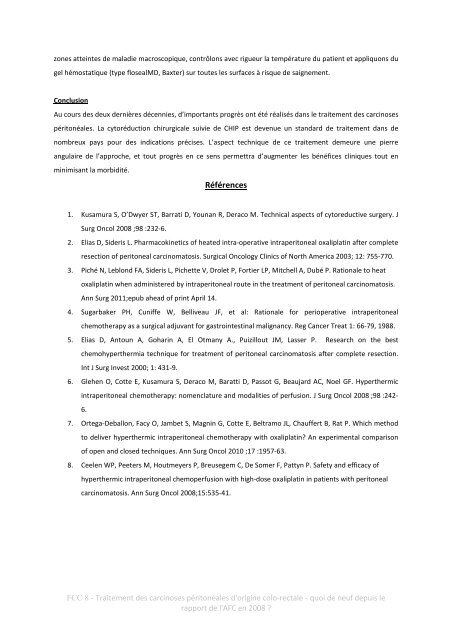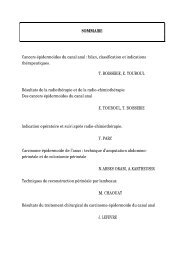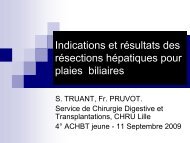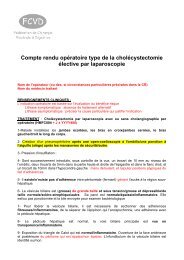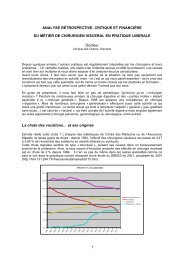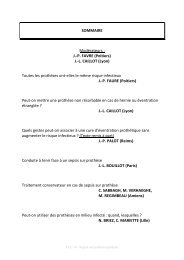Traitement des carcinoses péritonéales d'origine colo-rectale. Quoi ...
Traitement des carcinoses péritonéales d'origine colo-rectale. Quoi ...
Traitement des carcinoses péritonéales d'origine colo-rectale. Quoi ...
You also want an ePaper? Increase the reach of your titles
YUMPU automatically turns print PDFs into web optimized ePapers that Google loves.
zones atteintes de maladie macroscopique, contrôlons avec rigueur la température du patient et appliquons du<br />
gel hémostatique (type flosealMD, Baxter) sur toutes les surfaces à risque de saignement.<br />
Conclusion<br />
Au cours <strong>des</strong> deux dernières décennies, d’importants progrès ont été réalisés dans le traitement <strong>des</strong> <strong>carcinoses</strong><br />
<strong>péritonéales</strong>. La cytoréduction chirurgicale suivie de CHIP est devenue un standard de traitement dans de<br />
nombreux pays pour <strong>des</strong> indications précises. L’aspect technique de ce traitement demeure une pierre<br />
angulaire de l’approche, et tout progrès en ce sens permettra d’augmenter les bénéfices cliniques tout en<br />
minimisant la morbidité.<br />
Références<br />
1. Kusamura S, O’Dwyer ST, Barrati D, Younan R, Deraco M. Technical aspects of cytoreductive surgery. J<br />
Surg Oncol 2008 ;98 :232-6.<br />
2. Elias D, Sideris L. Pharmacokinetics of heated intra-operative intraperitoneal oxaliplatin after complete<br />
resection of peritoneal carcinomatosis. Surgical On<strong>colo</strong>gy Clinics of North America 2003; 12: 755-770.<br />
3. Piché N, Leblond FA, Sideris L, Pichette V, Drolet P, Fortier LP, Mitchell A, Dubé P. Rationale to heat<br />
oxaliplatin when administered by intraperitoneal route in the treatment of peritoneal carcinomatosis.<br />
Ann Surg 2011;epub ahead of print April 14.<br />
4. Sugarbaker PH, Cuniffe W, Belliveau JF, et al: Rationale for perioperative intraperitoneal<br />
chemotherapy as a surgical adjuvant for gastrointestinal malignancy. Reg Cancer Treat 1: 66-79, 1988.<br />
5. Elias D, Antoun A, Goharin A, El Otmany A., Puizillout JM, Lasser P. Research on the best<br />
chemohyperthermia technique for treatment of peritoneal carcinomatosis after complete resection.<br />
Int J Surg Invest 2000; 1: 431-9.<br />
6. Glehen O, Cotte E, Kusamura S, Deraco M, Baratti D, Passot G, Beaujard AC, Noel GF. Hyperthermic<br />
intraperitoneal chemotherapy: nomenclature and modalities of perfusion. J Surg Oncol 2008 ;98 :242-<br />
6.<br />
7. Ortega-Deballon, Facy O, Jambet S, Magnin G, Cotte E, Beltramo JL, Chauffert B, Rat P. Which method<br />
to deliver hyperthermic intraperitoneal chemotherapy with oxaliplatin? An experimental comparison<br />
of open and closed techniques. Ann Surg Oncol 2010 ;17 :1957-63.<br />
8. Ceelen WP, Peeters M, Houtmeyers P, Breusegem C, De Somer F, Pattyn P. Safety and efficacy of<br />
hyperthermic intraperitoneal chemoperfusion with high-dose oxaliplatin in patients with peritoneal<br />
carcinomatosis. Ann Surg Oncol 2008;15:535-41.<br />
FCC 8 - <strong>Traitement</strong> <strong>des</strong> <strong>carcinoses</strong> <strong>péritonéales</strong> <strong>d'origine</strong> <strong>colo</strong>-<strong>rectale</strong> - quoi de neuf depuis le<br />
rapport de l'AFC en 2008 ?


